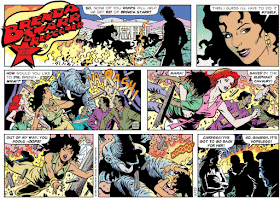The KINETIC is a potentiality that describes the relationships of sensations.
The DRAMATIC is a potentiality that describes the relationships of discrete personalities.
The DIDACTIC (formerly "thematic") is a potentiality that describes the relationships of abstract ideas.
The MYTHOPOEIC is a potentiality that describes the relationships of symbols.
Merriam-Webster defines "potentiality" as "the ability to develop or to come into existence," and I chose it in accordance with my belief that all human creators of art are capable to drawing upon these potential matrices of relationships. Not all creators will use all four equally, for reasons I've already detailed, but all are potentially capable of invoking such intra-literary relationships because such relationships are the essence of all discourse. Naturally, I'm only interested in discourse that either falls within the rubric of "fiction" or has an ambiguous relationship to it (see my review of ED GEIN, which I termed a work of "fictionalized reality.")
Now, by certain criteria everything fictional is "unreal," as I demonstrated in my essay HERE COMES DAREDEVIL THE MAN WITHOUT IDENTITY. Still, even though fictional characters exist only for readers to identity with them in some manner, characters may take on the appearance of reality because they repeatedly reproduce the relationships we as readers/audiences expect of them. This illusion of reality is primarily sustained by the readers' sense of what Raymond Durgnat called "density of specification." This was a slight misquote of a tossed-off term from Henry James, and in Durgnat's original essay he seems to apply it largely to the potentiality that I have called The Dramatic:
English masters instructed us all in the necessity for realistic and deep characterization, logically consistent behavior, penetrating studies of motive, and that proliferation of vivid detail suggested by Henry James' phrase, "density of specification."
In certain circumstances one might argue that the last of Durgnat's phrases, "the proliferation of vivid detail," could signify the world of The Kinetic, but it's impossible to know what Durgnat had in mind, and I would speculate that in the type of realistic fiction he referenced, such "vivid detail" usually serves more as backdrop from dramatic developments than as a source of varied sensations. But in this one germ from Durgnat's essay, I perceive a general principle: that density is the means by which the reader subconsciously rates one creator above another: because the reader believes that Creator A can better describe a set of relationships so "densely" that it takes on the quality of "lived experience." Thus, using comics-creators as shorthand for these positions: abstract ideas take on great density in Dave Sim, sensations take on great density in Frank Miller, "discrete personalities" take on great density in (say) Gilbert Hernandez, and symbols take on great density in (say) Grant Morrison.
Such shorthand assignments are, of course, entirely unfair: Miller, Sim, Hernandez, and Morrison have all earned places in my mythcomics assessments, which indicates that all four possess some ability to work with the matrix of The Mythopoeic. But I would say that the dominant works by each artist show that one particular potentiality has what Jung called "sovereignty" over the others, as I detailed in JUNG AND CENTRICITY:
Jung does not invoke "sovereignty" as a specific term, in contrast to the way Bataille uses it to mean what I'd translate as "megalothymotic dominance." What Jung is really addressing is the proposition that though a subject's psychological makeup may include influences from all four functions-- once again, sensation, intuition, feeling, and thinking-- only one can be dominant.
Yet the question of centricity and/or "megalothymotic dominance" is not a vital one for me at this time. I'm more interested in exploring the consistency of unreality: the various types of non-existent fictional items that exist in assorted relationships within each respective potentiality. All of these items-- sensations, discrete personalities, symbols and ideas-- derive from things that people feel and/or do in the real world. But in fiction, they have their own reality, one that I have called, following Susanne Langer, gestural.
And in the next essay I'll finally draw, as promised, upon my essay THE QUANTUM THEORY OF DYNAMICITY, if only to come up with a better term than "items" for these intangible whatyacallems.

































